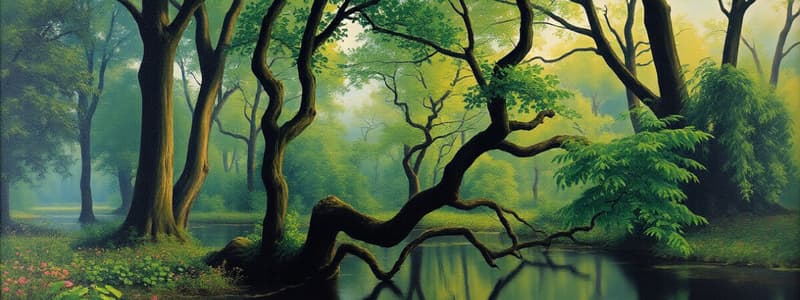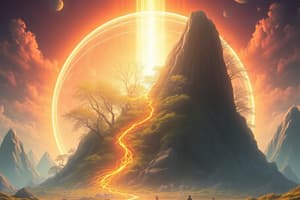Podcast
Questions and Answers
Which type of relationship benefits both species involved?
Which type of relationship benefits both species involved?
- Mutualism (correct)
- Parasitism
- Competition
- Commensalism
All organisms compete for resources even if they are abundant.
All organisms compete for resources even if they are abundant.
False (B)
What is the term for organisms that get energy from dead material?
What is the term for organisms that get energy from dead material?
Decomposer
A __________ is an animal that eats both plants and animals.
A __________ is an animal that eats both plants and animals.
Match the ecological term with its corresponding description:
Match the ecological term with its corresponding description:
Which of the following is a major source of air pollution?
Which of the following is a major source of air pollution?
Pollution can occur from naturally harmless materials if they accumulate in the environment.
Pollution can occur from naturally harmless materials if they accumulate in the environment.
What term describes the organism that is captured and eaten by a predator?
What term describes the organism that is captured and eaten by a predator?
What is likely to happen to the tropical ecosystem if the climate becomes cold and snowy over thousands of years?
What is likely to happen to the tropical ecosystem if the climate becomes cold and snowy over thousands of years?
Abiotic factors have no impact on the populations in an ecosystem.
Abiotic factors have no impact on the populations in an ecosystem.
What are the two main categories that compose an ecosystem?
What are the two main categories that compose an ecosystem?
All organisms need energy to fuel their life processes, which they obtain from ________.
All organisms need energy to fuel their life processes, which they obtain from ________.
Match the roles of organisms to their definitions:
Match the roles of organisms to their definitions:
Which statement best describes what producers do in an ecosystem?
Which statement best describes what producers do in an ecosystem?
What is the primary cause of acid rain?
What is the primary cause of acid rain?
Water pollution can affect food webs in an ecosystem.
Water pollution can affect food webs in an ecosystem.
Food webs show only the interactions among producers in an ecosystem.
Food webs show only the interactions among producers in an ecosystem.
What can happen to species when their environment no longer meets their needs?
What can happen to species when their environment no longer meets their needs?
What is the significance of decomposers in an ecosystem?
What is the significance of decomposers in an ecosystem?
When humans clear land for agriculture, they often cause __________ to the environment.
When humans clear land for agriculture, they often cause __________ to the environment.
Match the type of pollution with its source:
Match the type of pollution with its source:
Which of the following is NOT a reason for species extinction?
Which of the following is NOT a reason for species extinction?
Identify a human activity that contributes to climate change.
Identify a human activity that contributes to climate change.
Landfills are meant only for biodegradable waste.
Landfills are meant only for biodegradable waste.
What is a significant cause of population decline in many species?
What is a significant cause of population decline in many species?
Resource depletion can occur if trees are cut down faster than they can grow.
Resource depletion can occur if trees are cut down faster than they can grow.
How many species are estimated to be lost each year due to factors like habitat destruction?
How many species are estimated to be lost each year due to factors like habitat destruction?
Fossil fuels take billions of years to form and are considered a ______ resource.
Fossil fuels take billions of years to form and are considered a ______ resource.
Match the following causes of changes in ecosystems with their descriptions:
Match the following causes of changes in ecosystems with their descriptions:
What threatens fresh water supplies in some areas?
What threatens fresh water supplies in some areas?
The human population on Earth is decreasing rapidly.
The human population on Earth is decreasing rapidly.
Changes in ecosystems over time can be caused by both ______ and natural occurrences.
Changes in ecosystems over time can be caused by both ______ and natural occurrences.
What is the result of beavers cutting down trees to dam streams?
What is the result of beavers cutting down trees to dam streams?
Humans always intentionally change their environment.
Humans always intentionally change their environment.
What is commensalism?
What is commensalism?
Burning coal and oil causes carbon dioxide to __________ in the air.
Burning coal and oil causes carbon dioxide to __________ in the air.
Match the following changes to their effects:
Match the following changes to their effects:
Which of the following human activities can lead to unintentional environmental changes?
Which of the following human activities can lead to unintentional environmental changes?
The relationship between cattle egrets and livestock is an example of commensalism.
The relationship between cattle egrets and livestock is an example of commensalism.
What problems can too much carbon dioxide in the atmosphere cause?
What problems can too much carbon dioxide in the atmosphere cause?
Flashcards are hidden until you start studying
Study Notes
Ecosystems
- Ecosystems comprise biotic (living) and abiotic (nonliving) factors. Abiotic factors support living organisms.
- A population consists of individuals of the same species living in the same area.
- All populations in an ecosystem form its community.
- Abiotic factors like water, carbon dioxide, oxygen, and nitrogen cycle through ecosystems, influencing population sizes.
Energy Flow
- Organisms need energy for life processes, obtained through food.
- Producers make their own food using sunlight to convert carbon dioxide and water into sugars and oxygen.
- Consumers obtain energy by eating other organisms.
- Decomposers break down dead organisms and waste, recycling nutrients.
- Food chains and webs illustrate energy flow through an ecosystem.
- Energy pyramids depict decreasing energy availability within an ecosystem.
Interactions
- Predator-prey relationships influence population growth.
- Predators often cooperate when hunting.
- Organisms compete for resources, especially when limited.
- Symbiotic relationships involve interactions between organisms of different species:
- Mutualism: both species benefit.
- Commensalism: one species benefits, the other is unaffected.
- Parasitism: one species benefits, the other is harmed.
Ecosystem Changes
- Natural factors, like volcanic eruptions or forest fires, cause rapid ecosystem changes.
- Human actions also impact ecosystems, affecting both biotic and abiotic components.
- Changes can result in:
- Climate change
- Species extinction
- Reduced species diversity
- Resource depletion
- Pollution of air, water, and land
Pollution
- Pollution involves harmful materials added to air, water, and land.
- Air Pollution:
- Fossil fuel burning (coal, oil) releases chemicals causing breathing problems and acid rain.
- Water Pollution:
- Chemicals (fertilizers, waste) dumped into water sources.
- Oil spills.
- Soil Pollution:
- Pollutants from precipitation or polluted water flowing through soil.
- Can affect plants, food webs, and species diversity.
- Improper waste disposal contributes to land pollution.
Species Extinction
- Extinction is the complete disappearance of a species.
- Natural changes can cause extinction.
- Human activities, leading to habitat destruction, are a major driver of extinction:
- Land clearing for development, agriculture, mining, and infrastructure.
- Introduction of invasive species.
Resource Depletion
- The human population is rapidly growing, increasing resource demand.
- Non-renewable resources (fossil fuels, metals) are depleted faster than they can be replenished.
- Renewable resources like trees can be depleted if used faster than their regeneration rate.
- Water depletion can occur if fresh water is used faster than it can be replenished.
Natural Changes
- Ecosystems change over time, driven by natural events.
- Sudden changes:
- Volcanic eruptions, forest fires, floods.
- Gradual changes:
- Beaver dams altering stream flow.
- Resulting in shift of plant and animal communities.
Changes Caused by Humans
- Humans modify their environment to meet their needs, affecting ecosystems:
- Logging destroys habitats and alters forest composition.
- Accidental events like forest fires and pollution can harm organisms and disrupt food webs.
- Climate change is caused by the release of greenhouse gases, primarily carbon dioxide, resulting from fossil fuel burning.
- This accelerated warming can lead to glaciers melting, sea level rising, and disruptions to ecosystems.
Commensalism
- A type of symbiotic relationship where one species benefits while the other is unaffected.
- Examples:
- Cattle egrets following grazing livestock to feed on insects.
- Tropical vines growing on trees, benefiting from access to sunlight.
Studying That Suits You
Use AI to generate personalized quizzes and flashcards to suit your learning preferences.




